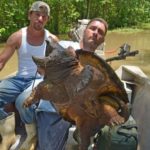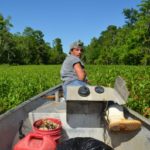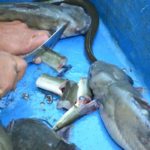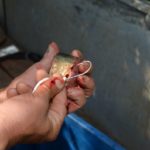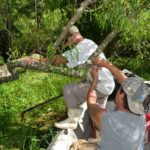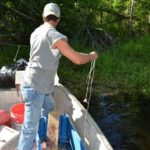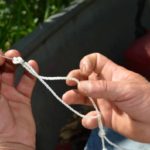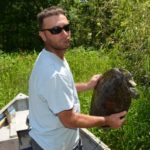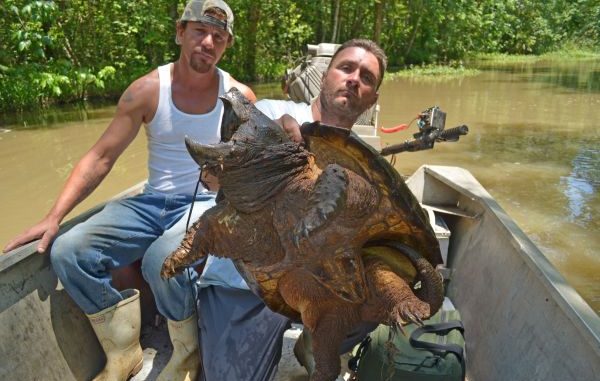
Lake Des Allemands is full of more than bass, crappie and bream. These two locals know snapping turtles also lurk beneath the surface — and provide incredible table fare.
The huge, scaly beast — its massive body partially supported by the water — swim-crawled its way along the soft, mucky bottom. Its bear-like, long, black claws stirred up clouds of half-decayed vegetation and silt.
Bubbles of swamp gas rose lazily to the water’s surface.
The alligator snapping turtle was on the prowl — looking for something to eat. It wasn’t choosy. Acorns would be fine; so would crawfish, clams and even the stray crab. A smaller turtle, one whose shell it could crush with its massive cleaver-like jaws, would be tops on the list.
Of course, things didn’t have to be alive to be on the monster’s menu. It would eat anything dead — the riper the better: fish, snakes, raccoons, or nutria.
Smaller items it would eat in one bite. Bigger stuff, it would hold down with its front feet and rip apart with its jaws.
Tiring of actively hunting and scavenging, the big reptile went into an ambush predator mode. It settled its huge bulk on the soft bottom, and menacingly yawned its gaping jaws wide open. It’s heavily ridged shell, completely encrusted with algae, blended into the background. Its muscular neck and part of its head was camouflaged by fleshy, branching fingers of skin.
As the suspended silt settled and the water cleared, a small remarkably wormlike projection popped out of the top of its tongue. A passing bluegill caught one of the turtle’s small, bright, green-and-black striated eyes. Immediately the turtle’s fishing lure began a contorted dance in imitation of a worm in distress. The protrusion’s bright-pink color made it highly noticeable in the otherwise mottled green interior of the mouth.
Sensing an easy meal, the bluegill closed in on the wiggling lure and pecked it. With the speed of light, the turtle’s hooked jaws snapped shut on the hapless fish.
A couple of minutes later, the jaws opened back up, and the turtle began fishing again.
Not far away, but unbeknownst to the turtle, another predator lurked. Like the turtle, he had to catch things to survive. He was a commercial fisherman.
Like the turtle, he ate anything. He was a Cajun.
“Hey, Nooch, let’s set a line over there,” Mark Fonseca barked. “That looks like a real good spot for a loggerhead.”
Forty-one-year-old Fonseca is a commercial fisherman like his father and his grandfather before him. Like any good Cajun, he carries a nickname from childhood: “Fideaux” in this case.
But he is just as likely not to acknowledge it as to answer to it.
Nooch, on the other hand, revels in his nickname.
“My daddy gave me that name, He said that I looked like a little nutria when I was born,” Nooch said.
Christened Hermilo Duran III 39 years ago, he never answers to anything but Nooch.
Late in the morning, after Fonseca had run his catfish nets, the pair headed up the bayou from the fishing community of Des Allemands. Before leaving the little town, they stopped at Kevin “Captain Hook” Cortez’s boat shed to cadge some eels for bait from their fellow commercial fisherman.
From there, their destination was the network of canals surrounding Lake Des Allemands.
Duran’s erstwhile employment is as a helper on Fonseca’s fishing boat, but that morning he wasn’t with Fonseca.
“Fideaux fired me last week,” he explained. “I didn’t show up to run nets.”
He grinned broadly, as if anticipating the question of why he was here.
“But we’re still podnahs,” Duran said. “I got drunk. No-Show Nooch! I’ve been fired at least five or six times in a year. But I always get rehired. I’ll get rehired.”
He seemed confident.
A glance at Fonseca showed him hanging his head and slowly shaking it. He sighed softly.
It was a gorgeous spring day. With spring, the freshwater marsh and swamp had turned vibrant green. The bayou smelled rich and fishy. The bayou widened into Baie du Deux Chenes (Two Oaks Bay), which in turn opened into Lac Des Allemands, the “Lake of the Germans” in French.
Fonseca piloted the boat past the eastern shore of the lake, with its dense stands of cypress that extend into the lake bed.
“There are lots of turtles up in the cypress trees,” he explained, “but I don’t want to set out there because alligators will take the bait. Also turtles will wrap the line up in the (cypress) knees and drown.”
Once in the lake, Fonseca stopped to remove a few channel catfish from one of his hoop nets.
“Freshwater eels and catfish, especially pollywogs (aka mud cats or bullheads) are excellent turtle bait,” he said, “because they are found everywhere.
“Pump canals are wide open and clean (of vegetation). Mullet and shad are best there because those fish are attracted to water currents.”
Their first canals, on the eastern side of the lake, were choked with vegetation.
“There is plenty of water under the grass,” explained Fonseca as he used his surface drive to chop through the green stuff.
It was almost a jungle scene — a riot of green. Cypress and maple trees lined the banks, their green punctuated by snowy-white egrets. Small patches of black water opened up in the floating vegetation in places, revealing alligators and slithering snakes.
“We don’t fish loggerheads (alligator snappers) commercially,” Fonseca said. We always did it for fun. We did this since we were kids. I caught my first one at 9 years old.
“I learned from my grandpa, George Rulet.”
Duran looked up from his task, cutting eels and catfish into sizeable chunks for bait.
“I learned everything about fishing from my dad, Pete, except hoop nets. I learned that from Fideaux,” he said, nodding to Fonseca in the back of the boat.
The pair was going to use three types of fishing gear: drop lines, trotlines and jug lines.
Drop lines were simple: 15 feet of white (untarred) nylon twine with a 6/0 hook on one end.
White nylon is preferred because it is softer, not as easy for the turtle to detect and more difficult for a turtle to grip in its jaws and cut.
A 8-inch or so loop was tied on the end of the line, which was in turn inserted through the eye of the hook. Before being looped over the hook for tightening, the hook was given a half-turn. If a turtle cuts one of the lines of the loop, the other one will still hold the turtle, Duran explained.
The men carefully inspected spots along the bank for what their intuition told them were good sets. Many of them seemed to be random, but they never passed an opportunity to set a line beneath a low, overhanging shrub or tree limb.
Many of the places had so much vegetation that a potato rake (an indispensable tool for setting drop lines) had to be used to clear a spot to drop the baited hook.
The other end of the line was tied to whatever was convenient. Sometimes it was a big tree. Other times it was a relatively small tree branch. A turtle deeply hooked, commented Fonseca will not pull hard on the line.
The extra line was loosely coiled on a tree branch or on top of nearby vegetation. The objective is to give the turtle enough slack line to allow it to swallow the bait and become hooked internally. A turtle that is mouth-hooked will often bend the big hook in its jaws and escape.
Duran set his hooks so the bait rested on the bottom, while Fonseca often set the bait so it was suspended a few inches off the bottom, letting the line coils on the vegetation hold it off the bottom.
Both men were careful with hook placement, wanting the point barely exposed through the bait.
“Early in spring, when turtles first come out of their winter holes, they are aggressive and grab anything,” Fonseca explained. “ Later they get finicky and may spit out the bait if they feel the hook.
The set is completed by tying a piece of white plastic flagging to the tree to mark the set so it can be easily relocated.
They repeated this scenario 11 times in the first canal, talking while they worked.
“You want to look for secluded places like dead-end canals to set turtle lines,” Fonseca said. “An old canal with a lot of oak trees is good. They eat acorns and mulberries. Under a mulberry tree is a good set.”
Duran clearly loves to fish turtles, repeating lessons learned from his commercial fisherman father.
“Fresh bait sinks to the bottom, where a turtle will get it. After two days, when it floats is when an alligator will get it.”
Fonseca expanded on Duran’s comments.
“I will usually run my lines without rebaiting twice or even three times after setting them,” Fonseca said. “Lots of times the second day is better than the first.
“Turtles bite best in thunderstorms.”
Duran nodded in agreement.
“Thunder and lightning makes them move and feed,” he said.
“It increases the chance of a catch by four times,” Fonseca said.
At an open spot in the canal, the men set the second piece of gear they will use — a trotline.
One end of the main line was tied to a tree on one bank and the other to a tree on the opposite bank. The trotline also was constructed of white nylon and hooks.
One-foot-long hook-bearing loops (called “snoots”) are spaced 5 or 6 feet apart the length of the main line. In the center of the line, Duran tied a 6-inch piece of steel rebar, just enough weight to keep the bait from floating and attracting alligators, as well as to prevent a passing boat from cutting the line.
Fonseca noted that it was important to leave a lot of slack in the line and added, “Trotlines work best when you have some current in the water. I can’t explain why, but they do.”
They finished off the first canal by setting 10 jug lines, the third of the three types of gear they used.
These are simply 2-liter soft-drink bottles painted red for easy visibility, each with a 4-foot length of nylon tied around the neck of the bottle and a hook on the other end of the line.
The nylon on Fonseca’s jug lines was tarred because they receive most of their use fishing for catfish or, with a length of wire leader added, for garfish.
As Fonseca ran the boat and unwrapped the lines from around the jugs’ necks, Duran baited the hooks and tossed the jugs to the shallower water on either side of the canal. They counted the jugs so they would know if a turtle pulled one of them under the profuse vegetation or even up under a cut bank.
They hop-scotched to another canal and set three drop lines and 10 more jugs.
From there, they went to a third spot, a small slough where they set five drop lines. In the fourth and final canal, one so overgrown with vegetation that only a thin seam of open water existed in the center of the canal, they set their last 15 jug lines.
They talked about eating turtle while they set their last jug lines.
“It’s a delicacy,” said Duran, “Very good stuff. Few people get it.”
Fonseca agreed.
“I really like it. If it’s cooked right it’s very good,” he said. “You brown it in small batches to keep it firm. Starting too much turtle in a pot boils it, and makes it stringy and mushy.
“Softshell turtles are really good too, but snappers and loggerheads under 25 pounds are best. Meat from big turtles needs to be cooked longer; don’t try cooking meat from a big and a little turtle together. It won’t work.”
Duran was fairly drooling during the discussion on eating turtles.
The next morning, again after Fonseca had completed his fishing chores, the two men set out to check their lines. Their anticipation was palpable.
The first canal was a big let-down — not a single turtle. One jug line was missing.
In the clipped Cajun accent unique to Des Allemands, Fonseca speculated that someone took it or a turtle pulled it under the floating mats of vegetation in the canal.
They left the drop lines and trotline to check the next day, but picked up the jug lines.
The next canal was deflating. Only one small softshell turtle about the size of a big pancake — barely big enough to clean. Again, they picked up all their jug lines.
The third spot, with only five drop lines, looked especially promising to Fonseca the day before, but yielded nothing.
Everything rode on the fourth canal. Halfway through picking up the jugs, a big, 25-pound softshell turtle, hooked in one leg rather than the mouth, came up.
“That turtle can feed a bunch of people,” said Fonseca. “You can make a big gravy with it. It probably has 8 or 10 pounds of meat.”
Fonseca consoled himself as he ran the boat to another canal to reset their jug lines.
“That’s what they call fishing,” he said.
“Yup,” agreed Duran. “Sometimes you set out a hundred lines and catch nothing.”
“I’ve seen that, too,” Fonseca said.
Resetting the jugs in the small canal went quickly. Fonseca turned the boat around to run back out of the canal. Near the mouth of the canal, two of the jugs had floated close together in the middle of the canal.
“Nooch, grab one of those jugs so we can move it,” ordered Fonseca, who kept the boat moving at a pretty good clip.
Duran dutifully snatched the jug in his hand to flip it out of the middle of the canal.
He was almost pulled overboard.
Before he could let go of the jug, a big, scaly tail and the pointed-back plates of a big turtle’s shell rolled to the surface.
Both men started shouting, with Duran crying, “Stop, stop, stop!” and Fonseca yelling, “Loggerhead, loggerhead!” all the while trying to slam the motor in reverse.
Nothing could have been more beautiful than the big, scaly reptile, gaping its cruelly hooked jaws in a threat display, being pulled into the boat.
Rags to riches — and the jugline had been set less than 30 minutes before.
